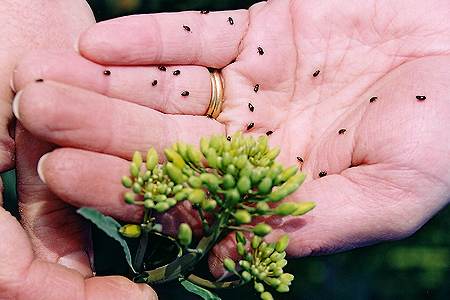Pests in oilseed rape, April 2019
4 April 2019With many crops already at green-yellow bud, there is a risk from pollen beetle damage to the buds, giving rise to blind-stalks with no flowers or pods forming on them. The current drop in temperatures will stop pollen beetles moving into crops as they only fly when temperatures reach 15°C.
When beetles appear in crops, note that there are updated thresholds for treatment. The plant density needs to be taken into account to estimate the threat from pollen beetles at green-yellow bud.
• Less than 30 plants/m2 – threshold is 25 pollen beetles/plant
• Between 30-50 plants/m2 – threshold is 18 pollen beetles/plant
• Between 50-70 plants/m2 – threshold is 11 pollen beetles/plant
• Greater than 70 plants/m2 – threshold is 7 pollen beetles/plant
If crops are backward because of poor overwintering, slug problems in the autumn or pigeon damage, then their capacity to cope with pollen beetle damage is reduced, so a lower threshold should be adopted for these crops. These thresholds have been revised to help deal with the increased threat from pyrethroid insecticide pollen beetles in UK crops by ensuring that insecticides are only applied when necessary.
Resistance in pollen beetles to pyrethroid insecticides has been found in Scotland. The advice to growers is that pyrethroid insecticide use for pollen beetle control should only be used if the treatment thresholds have been exceeded. Remember that once the crop is in flower the beetles can easily reach the pollen they desire without damaging the flower, so no flowering crops should be sprayed for pollen beetle control.
Sign up to the FAS newsletter
Receive updates on news, events and publications from Scotland’s Farm Advisory Service

